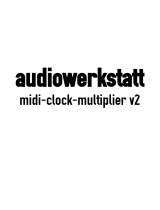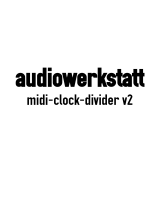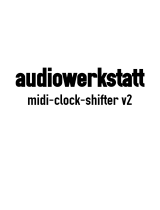audiowerkstatt trigger2midi2trigger V2 Bedienungsanleitung
- Typ
- Bedienungsanleitung

audiowerkstatt
trigger2midi2trigger v2

audiowerkstatt trigger2midi2trigger v2
Der audiowerkstatt trigger2midi2trigger v2 konvertiert analoge Trigger-Clock- in MIDI-Clock-Signale und umgekehrt. Ausserdem
ist es als multifunktionales analoges Trigger-Werkzeug einsetzbar.
Anschl sse:
9-12v: Eingang zum Anschluss eines Netzteils 9-12V AC oder DC (Polung spielt keine Rolle)].
midi-in: Eingang zum Anschluss des MIDI-Ausgangs vom MIDI-Master.
midi-out: Ausgang zum Anschluss des MIDI-Eingangs vom MIDI-Slave.
clock: Stereo-Anschluss zum Austausch analoger Trigger-Clock-Signale (Der Ausgang liegt auf dem Pin und der
Eingang auf dem Ring der Buchse).
start/stop: Stereo-Anschluss zum Austausch analoger Start-/Stop-Signale.(Der Ausgang liegt auf dem Pin und der
Eingang auf dem Ring der Buchse).
Funktion der Knöpfe und LEDs:
Die LEDs zeigen die Einstellungen des Gerätes an. Die LEDs der Einstellmöglichkeit, die gerade bearbeitet werden kann, blinken.
Durch kurzes Dr cken des oberen Knopfes kann zur nächsten Einstellmöglichkeit gewechselt werden, mit den beiden unteren
Knöpfen wird diese eingestellt.
Wird der obere Knopf gehalten, leuchten alle LEDs. Nun dient der linke untere Knopf dazu, manuell einen Stop-Vorgang
auszulösen und der rechte untere Knopf dazu, manuell einen Start-Vorgang auszulösen.
Alle Einstellungen werden automatisch gespeichert und beim Neustart des Gerätes geladen.
Anwendungsmöglichkeiten:
1. Trigger-Clock-zu-MIDI-Clock-Wandler und MIDI-Clock-zu-Trigger-Clock-Wandler:
In dieser Verwendung wird bei laufender Master-Clock an der midi-out -Buchse immer ein MIDI-Clock-Signal (incl.
Start-/Stop-Signal) ausgegeben. An der Spitze (Tip) der clock -Klinkenbuchse wird bei laufender Master-Clock immer ein
analoges Trigger-Clock-Signal (V-Trigger: 0V/5V Pulse; S-Trigger: offen / geschlossen ) ausgegeben. An der Spitze (Tip) der
start-/stop -Buchse liegt bei V-Trigger im Ruhezustand 0V, bei laufender Clock 5V an und bei S-Trigger befindet sich der
Ausgang im Ruhezustand im Zustand offen , bei laufender Clock geschlossen .
Mit der ersten Einstellmöglichkeit input wird die Quelle der Clock ausgewählt. In der Einstellung midi wird die an der
midi-in -Buchse anliegende MIDI-Clock (incl. Start-/Stop-Befehl) verwendet. In der Einstellung trigger wird die am Ring der
clock -Klinkenbuchse anliegende analoge Trigger-Clock sowie das an der start-/stop -Klinkenbuchse anliegende Signal
ausgewertet und als Clock verwendet. Zum Anschlie en kann ein handels bliches Insert-Kabel benutzt werden.
Mit der zweiten Einstellmöglichkeit trigger.type in kann eingestellt werden, ob es sich bei dem eingehenden analogen Clock-
Signal um eines des Typs V-Trigger oder S-Trigger handelt.
Ist midi als Clock-Quelle gewählt, spielt diese Einstellung keine Rolle.
Mit der dritten Einstellmöglichkeit trigger.type out kann eingestellt werden, ob es sich bei dem ausgehenden analogen Clock-
Signal um eines des Typs V-Trigger oder S-Trigger handelt.
Mit der vierten Einstellmöglichkeit clock.divider in kann eingestellt werden, als was die am clock -Eingang anliegende
analoge Trigger-Clock interpretiert werden soll. Handelt es sich bei dieser z.B. um 16tel, so wird 1/16 gewählt und handelt es
sich z.B. um 4tel, so wird gewählt.
Wird diese Einstellung nicht korrekt vorgenommen, so läuft die ausgegebene Clock zwar synchron zur Eingangs-Clock, aber in
falschem Tempo.
Ist midi als Clock-Quelle gewählt, spielt diese Einstellung keine Rolle.

Mit der f nften Einstellmöglichkeit clock.divider out kann der Clock-Divider der ausgegebenen analogen Trigger-Clock
eingestellt werden.
Mit der sechsten Einstellmöglichkeit pulse.length kann die Länge des Clock-Impulses eingestellt werden.
Die kleinste Stufe ist sehr kurz und die grö te sehr lang, wodurch manche Geräte zu Fehltriggern neigen. Verwende mit diesen
Geräten dann nur eine k rzere bzw. längere pulse.length !
Die ausgangsseitigen Einstellmöglichkeiten (trigger.type out, clock.divider out und pulse.length) können auch bei laufender Clock
umgestellt werden, ohne dass die Synchronisation hierdurch beeinträchtigt wird.
Neben der Clock-Signale, werden auch die Start-/Stop-Signale der gewählten Quelle ausgewertet und gesendet, es kann jedoch
parallel auch manuell ein Stop oder Start ausgelöst werden.
Wird der obere Knopf gehalten, leuchten alle LEDs. Nun dient der linke untere Knopf dazu, manuell einen Stop-Vorgang
auszulösen und der rechte untere Knopf dazu, manuell einen Start-Vorgang auszulösen.
2. Trigger-Werkzeug:
Der audiowerkstatt trigger2midi2trigger v2 kann auch als hilfreiches Werkzeug im Umgang mit analog-Triggern verwendet
werden, wenn er nicht als Clock-Wandler verwendet wird.
Die Einstellung input muss hierbei immer auf trigger gesetzt sein.
a) S-Trigger zu V-Trigger Wandler:
Wenn Du trigger.type in auf s-trigger und trigger.type out auf v-trigger stellst, hast Du einen S-Trigger zu V-
Trigger -Wandler, wobei der Ring der start/stop -Buchse als Eingang und die Spitze (Tip) als Ausgang fungiert.
Zum Anschlie en kann ein handels bliches Insert-Kabel verwendet werden.
b) V-Trigger zu S-Trigger Wandler:
Wenn Du trigger.type in auf v-trigger und trigger.type out auf s-trigger stellst, hast Du einen V-Trigger zu S-
Trigger -Wandler, wobei der Ring der start/stop -Buchse als Eingang und die Spitze (Tip) als Ausgang fungiert.
Zum Anschlie en kann ein handels bliches Insert-Kabel verwendet werden.
c) analoger Clock-Divider:
Wenn Du clock-divider in auf 1/32 stellst, hast Du einen analogen Clock-Divider, wobei der Ring der clock -Buchse als
Eingang und die Spitze (Tip) als Ausgang fungiert. Mit clock-divider out kannst du nun den Teiler einstellen: 1/32 belässt
die Clock ungeteilt, 1/16 halbiert sie, 1/8 teil sie durch 4 und 1/4 durch 8.
Mit trigger.type in und trigger.type out können die Trigger-Formate und mit pulse.length die Länge des Clock-Impulses
eingestellt werden.
Zum Anschlie en kann ein handels bliches Insert-Kabel verwendet werden.
d) analoger Clock-Multiplier:
Wenn Du clock-divider in auf 1/4 stellst, hast Du einen analogen Clock-Multiplier, wobei der Ring der clock -Buchse als
Eingang und die Spitze (Tip) als Ausgang fungiert. Mit clock-divider out kannst du nun den Faktor der Vervielfachung
einstellen: 1/4 belässt die Clock gleich, 1/8 verdoppelt sie, 1/16 multipliziert sie mal 4 und 1/32 mal 8.
Mit trigger.type in und trigger.type out können die Trigger-Formate und mit pulse.length die Länge des Clock-Impulses
eingestellt werden.
Zum Anschlie en kann ein handels bliches Insert-Kabel verwendet werden.
e) Gate to Trigger Wandler:
Wenn Du beim Booten des Gerätes einen der Knöpfe gedr ckt hältst, startet es in einem speziellen Modus. Die Clock-Wandler-
Funktion ist nun deaktiviert! Dies ist daran zu erkennen, dass die LEDs nun langsamer blinken, als zuvor.
Wenn Du nun pulse.length auf die kleinste Stufe stellst, hast Du einen Gate to Trigger Wandler, wobei der Ring der clock -
Buchse als Eingang und die Spitze (Tip) als Ausgang fungiert.
Mit trigger.type in und trigger.type out können die Trigger-Formate eingestellt werden.
Zum Anschlie en kann ein handels bliches Insert-Kabel verwendet werden.

Wenn Du beim nächsten Booten des Gerätes keinen der Knöpfe gedr ckt hältst, startet es wieder im normalen Clock-Wandel-
Modus.
f) Trigger zu Gate Wandler mit einstellbarer Gate-Länge:
Wenn Du beim Booten des Gerätes einen der Knöpfe gedr ckt hältst, startet es in einem speziellen Modus. Die Clock-Wandler-
Funktion ist nun deaktiviert! Dies ist daran zu erkennen, dass die LEDs nun langsamer blinken, als zuvor.
Du hast nun einen Trigger zu Gate Wandler, wobei der Ring der clock -Buchse als Eingang und die Spitze (Tip) als Ausgang
fungiert.
Mit trigger.type in und trigger.type out können die Trigger-Formate und mit pulse.length die Länge des Clock-Impulses
eingestellt werden.
Zum Anschlie en kann ein handels bliches Insert-Kabel verwendet werden.
Wenn Du beim nächsten Booten des Gerätes keinen der Knöpfe gedr ckt hältst, startet es wieder im normalen Clock-Wandel-
Modus.
Technische Daten:
Anschl sse: midi-in (5-pol DIN)
midi-out (5-pol DIN)
clock (Stereo-Klinkenbuchse 6,3mm)
start/stop (Stereo-Klinkenbuchse 6,3mm)
Netzteil (Plug 5,5mm, Pin 2,1mm)
Bedienelemente: select -Knopf
- oder stop -Knopf
+ oder start -Knopf
Anzeigeelemente: 2x Status-LED input
2x Status-LED trigger.type in
2x Status-LED trigger.type out
4x Status-LED clock.divider in
4x Status-LED clock.divider out
6x Status-LED pulse.length
Netzteil: 9-12V AC oder DC (Polung spielt keine Rolle)
Abmessungen: 112 mm x 72 mm x 48 mm
Gewicht: 290 g
Lieferumfang:
-
audiowerkstatt trigger2midi2trigger v2
- Handbuch (deutsch/englisch)
Kontakt:
audiowerkstatt UG (haftungsbeschränkt)
Weserstr. 78
12059 Berlin
Deutschland
info@audiowerkstatt.de
http://www.audiowerkstatt.de
WEEE-Reg.-Nr. DE 49518480

audiowerkstatt trigger2midi2trigger v2
The audiowerkstatt trigger2midi2trigger v2 converts analog trigger-clock-signals to MIDI-clock-signals and vice versa. It can
also be used as an analog trigger-tool.
Connectors:
9-12v: Input for connecting a power supply (9-12V AC or DC (polarity doesn't matter)).
midi-in: Input for connecting the output of the MIDI-master.
midi-out: Output for connecting the input of the MIDI-slave.
clock: Stereo-Jack for analog trigger-clock-signals (output is pin und input is ring of the jack).
start/stop: Stereo-Jack for analog start/stop-signals (output is pin und input is ring of the jack).
Function of the buttons and LEDs:
The LEDs display the settings. The LEDs of the setting that is selected for setup are flashing.
The left button is used to select, which setting you are editing, with the other two buttons, you can adjust the value.
If you hold the left button, all LEDs glow. The middle button can now be used to manually perform a stop and the right button, to
perform a start.
All settings will be saved and restored at startup.
Applications:
1. Trigger-clock- to MIDI-clock-converter and MIDI-clock- to trigger-clock-converter:
In this use, there is always a MIDI-clock-signal (incl. start/stop) sent at the "midi out"-jack and at the tip of the "clock"-phone-
jack, an analog trigger-clock-signal (v-trigger: 0v/5v pulse; s-trigger open/closed) is sent. The tip of the "start/stop"-phone-jack
is if v-trigger is used 5v while the masterclock is running and 0v while the masterclock is paused and if s-trigger is used it is
closed while the masterclock is running and open while the masterclock is paused .
With the first setting input , the clock-source is selected. If midi is selected, the, at the midi-in incoming midi-clock (incl.
start/stop) is used as clock-source. If trigger is selected, the, at the ring of clock incoming analog-pulse will be used as
clock-source and the, at the ring of start/stop incoming signal will be used as source for start/stop.
Normal insert-cables can be used to connect the analog inputs/outputs. If only the analog outputs are used, normal phone-jack-
cables (mono or stereo) can be used.
The second setting trigger.type in is used to select, if the incoming analog trigger-clock is a s-trigger - or a v-trigger -
signal.
If midi is used as clock-source, this setting has no effect.
The third setting trigger.type out is used to select, if the outgoing analog trigger-clock is a s-trigger - or a v-trigger -
signal.
The fourth setting clock.divider in is used to configure the clock-divider of the incoming analog trigger-clock. If the clock is
running at a speed og 1/16th, it is set to 1/16 , if the speed of the clock is a quarter-note, you set it to 1/4 .
If this is not set up propperly, the generated clock will be in sync, but not in the right way. It would run half speed or double or
something like that.
If midi is used as clock-source, this setting has no effect.

The fifth setting clock.divider out is used to configure the clock-divider of the outgoing analog trigger-clock.
The sixth setting pulse.length is used to configure the pulse-length of the outgoing analog trigger-clock. The smallest pulse-
length is really very short and the longest really very long. Some sequencers might have problems with that. If so, please select a
longer/shorter pulse.length.
The settings for the analog output (trigger.type out, clock.divider out und gate.length) can be changed without losing
synchronisation, while the masterclock is running.
In addition to the clock-signal, start-/stop-signals from the masterclock are detected and processed, but it it also possible to
send start-/stop-signals manual.
If you hold the left button, all LEDs glow. The middle button can now be used to manually perform a stop and the right button, to
perform a start.
2. Trigger-tool:
The audiowerkstatt trigger2midi2trigger v2 can also be used as a tool for analog-trigger-signals, if it isn't used as a converter.
In this case, the setting input has always to be set to trigger .
a) S-trigger to v-trigger -converter:
If trigger.type in is set to s-trigger and trigger.type out to v-trigger , you get a S-trigger to v-trigger -
converter, The ring of the start/stop -jack is input and the tip is output.
Normal insert-cables can be used to connect the analog input/output.
b) V-trigger to s-trigger -converter:
If trigger.type in is set to v-trigger and trigger.type out to s-trigger , you get a V-trigger to s-trigger -
converter, The ring of the start/stop -jack is input and the tip is output.
Normal insert-cables can be used to connect the analog input/output.
c) Analog clock-divider:
If clock-divider in is set to 1/32 , you get an analogen clock-divider. The ring of the clock -jack is input and the tip is
output. With the setting clock-divider out you can now set the divider: 1/32 leaves the clock as it is, 1/16 makes half
speed, 1/8 makes quarter-speed and 1/4 make it run 1/8th of the speed..
With trigger.type in and trigger.type out , the trigger-types can be set and with pulse.length , the length of the clock-
pulse can be adjusted..
Normal insert-cables can be used to connect the analog input/output.
d) Analog clock-multiplier:
If clock-divider in is set to 1/4 , you get an analogen clock-multiplier. The ring of the clock -jack is input and the tip is
output. With the setting clock-divider out you can now set the factor to multiplie: 1/4 leaves the clock as it is, 1/8 makes
it run double speed, 1/16 makes four times higher speed and 1/32 make it run 8 times faster.
With trigger.type in and trigger.type out , the trigger-types can be set and with pulse.length , the length of the clock-
pulse can be adjusted..
Normal insert-cables can be used to connect the analog input/output.

e) Gate to trigger converter:
If you hold one of the buttons while powering up, a special mode is started. The converter is now deactivated and the blinking if
the led is slower.
If you set the pulse.length to the smallest setting, you can use it as gate-to-trigger-converter. With trigger.type in and
trigger.type out , the trigger-types can be set. The ring of the clock -jack is input and the tip is output. Normal insert-cables
can be used to connect the analog input/output.
If you do not hold one of the buttons while powering up next time, the normal converter-mode is started again.
f) Trigger to gate converter with adjustable gate-length:
If you hold one of the buttons while powering up, a special mode is started. The converter is now deactivated and the blinking if
the led is slower.
Now you can use it as trigger-to-gate-converter. With trigger.type in and trigger.type out , the trigger-types can be set and
with gate.length , the length of the clock-pulse can be adjusted. The ring of the clock -jack is input and the tip is output.
Normal insert-cables can be used to connect the analog input/output.
If you do not hold one of the buttons while powering up next time, the normal converter-mode is started again.
Specifications:
Connectors: midi-in (5-pol DIN)
midi-out (5-pol DIN)
clock (stereo-phone-jack 6,3mm)
start/stop (stereo-phone-jack 6,3mm)
power (plug 5,5mm, Pin 2,1mm)
Control elements: select -button
- or stop -button
+ or start -button
Display elements: 2x Status-LED input
2x Status-LED trigger.type in
2x Status-LED trigger.type out
4x Status-LED clock.divider in
4x Status-LED clock.divider out
6x Status-LED pulse.length
Power: 9-12V AC or DC (Polarity doesn t matter)
Dimensions: 112 mm x 72 mm x 48 mm
Weight: 290 g
Scope of delivery:
-
audiowerkstatt trigger2midi2trigger v2
- manual (german/english)
Contact:
audiowerkstatt UG (haftungsbeschränkt)
Weserstr. 78
12059 Berlin
Germany
info@audiowerkstatt.de
http://www.audiowerkstatt.de
WEEE-Reg.-Nr. DE 49518480

audiowerkstatt 2018
-
 1
1
-
 2
2
-
 3
3
-
 4
4
-
 5
5
-
 6
6
-
 7
7
-
 8
8
audiowerkstatt trigger2midi2trigger V2 Bedienungsanleitung
- Typ
- Bedienungsanleitung
in anderen Sprachen
Andere Dokumente
-
 audiowerkstatt midi-clock-multiplier v2 Schnellstartanleitung
audiowerkstatt midi-clock-multiplier v2 Schnellstartanleitung
-
 audiowerkstatt midi-clock-divider v2 Schnellstartanleitung
audiowerkstatt midi-clock-divider v2 Schnellstartanleitung
-
 audiowerkstatt midi-clock-shifter v2 Schnellstartanleitung
audiowerkstatt midi-clock-shifter v2 Schnellstartanleitung
-
 audiowerkstatt din-restarter Quick Manual
audiowerkstatt din-restarter Quick Manual
-
Korg SQ-8 Bedienungsanleitung
-
Reloop Compact Daw Schnellstartanleitung
-
Akai MAX25 Benutzerhandbuch
-
Akai MAX49 Datenblatt
-
Akai MPK Mini Play Benutzerhandbuch
-
Roland MC-505 Bedienungsanleitung











